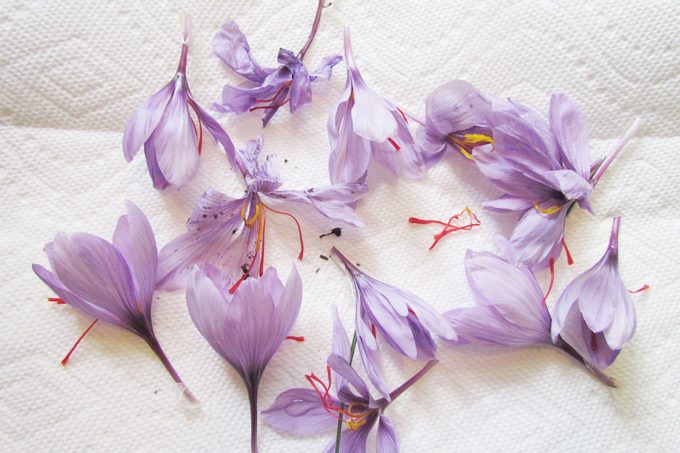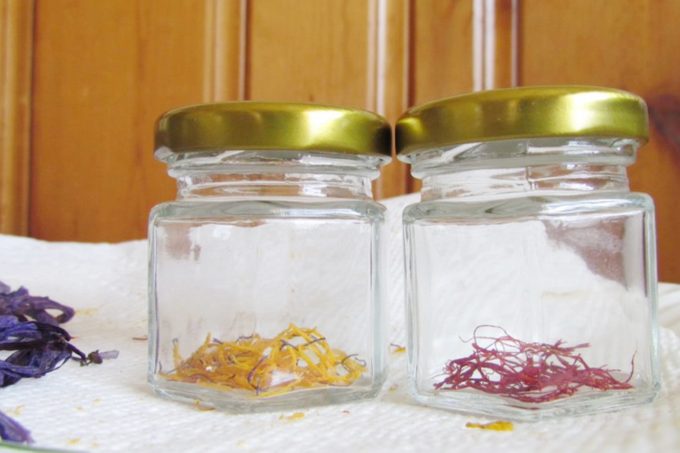

Just the other day, I paid $15 for 30 crocuses that will yield red strands of saffron, the world’s most expensive spice. This is the second time I’ve grown saffron. The last time I harvested the saffron threads, dried them and placed them in small glass jars to give to my foodie friends and family. A loosely packed tablespoon holds about one gram of saffron, which can cost up to $50 depending on the quality and country of origin!
On This Page
What Is Saffron?
Saffron is the three red strands (stigma) inside the purple flower of Crocus sativus. It only comes from this species of crocus. The strands can be used as a spice, dye, food coloring, perfume and herbal medicine.
India, Spain, Greece and Iran are the chief producers of saffron, with Iran growing about 90 percent of what’s on the market. It provides more income per square foot than traditional late-season crops like lettuces and other greens.
Generally, the red strands of saffron offer an earthy, honey-sweet, floral flavor that even chefs have a hard time describing. The yellow threads are stamens. These also can be used as a spice, with a slightly subdued flavor.
What Is Saffron Used For?
Traditionally, saffron flavors many dishes, including paella, rice, risotto and roasted chicken. It’s even an added flavor in vanilla ice cream and more.
Usually, the dried threads are crushed in a mortar and pestle, then soaked in one-quarter cup hot water. The spice steeps in the hot liquid, infusing it with the saffron flavor, fragrance and color. The liquid is what’s added to recipes. Fortunately, it only takes a pinch of crushed saffron threads to flavor a dish.
Why Is Saffron So Expensive?
Because harvesting it is labor-intensive. In countries where it’s grown, tens of thousands of crocuses are planted as a crop on many acres of land. The flowers only bloom for about one week, and the three red threads must be harvested by hand.
Approximately 250,000 stigmas make about one pound of saffron. It’s usually purchased in grams or fractions of an ounce. Two grams of saffron from Iran = $14. Two grams of saffron from Spain = $13. (Two grams = .071 ounce.)
How To Grow Saffron
Grow saffron crocus bulbs in a sunny area in the landscape or in a container with drainage holes. I’ve grown mine in the ground and in a window box that sits on the ground.
If you’re worried about squirrels and voles digging up and eating the bulbs, plant in pots. For additional in-ground protection, place chicken wire over the area. Saffron crocus is hardy in U.S. Department of Agriculture Plant Hardiness Zones 6 through 8.
How to plant saffron crocus
September and October are the best times. Plant the saffron crocus bulbs three inches deep. The bulb (technically a corm, which is similar to a bulb but without scales) is flat, so plant it with the hairy side down. Cover the bulbs, water well and wait. Don’t water again.
How to harvest saffron crocus

Saffron crocus bulbs will bloom six to eight weeks after planting. Once they bloom, snip off the flowers. Handle gently to avoid disturbing the saffron threads. Using tweezers or your fingers (I use the latter), pinch the red threads from the flower. Place the threads on a paper towel to dry for a day.
How to store saffron

After the threads have dried, put them in a small glass jar with a tight-fitting lid. Store in a cool dark place. Avoid exposing saffron to light. Although it does not spoil, saffron starts to lose its flavor after about six months.
What To Do With the Saffron Crocus Bulbs
Although they may be winter hardy in certain USDA Zones, most people overwinter the bulbs by digging them after harvest, drying them and storing in a cool, dark place. They are replanted in September or October of the following year. If grown in a container, move the whole thing to a protected area, like a porch or unheated garage.
I don’t rely on the bulbs wintering over so I plant new ones each year. The bulbs are inexpensive yet yield a lavishly delicious treat for yourself and others.
Did you miss our previous article…
https://tophouseimprovement.com/how-to/an-air-conditioner-that-has-moss-on-it/

